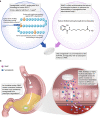A Pharmacological and Clinical Overview of Oral Semaglutide for the Treatment of Type 2 Diabetes
- PMID: 33964002
- PMCID: PMC8217049
- DOI: 10.1007/s40265-021-01499-w
A Pharmacological and Clinical Overview of Oral Semaglutide for the Treatment of Type 2 Diabetes
Abstract
Oral semaglutide (Rybelsus®) is a glucagon-like peptide-1 (GLP-1) receptor agonist (GLP-1RA) with 94% homology to human GLP-1. It is the first GLP-1RA developed for oral administration, and it comprises a co-formulation of the peptide semaglutide with the absorption enhancer sodium N-(8-[2-hydroxybenzoyl] amino) caprylate, which overcomes the challenges of peptide absorption in the acidic conditions of the stomach. Oral semaglutide is indicated for use as an add-on combination therapy (with other glucose-lowering agents, including insulin) or as a monotherapy (in patients who are intolerant to metformin) for type 2 diabetes when diet and exercise do not provide adequate glycemic control. In an extensive phase III clinical program including patients from across the disease spectrum, treatment with oral semaglutide resulted in effective glycemic control, reductions in body weight, and decreases in systolic blood pressure when used as monotherapy or in combination with other glucose-lowering therapies. Studies showed that oral semaglutide was well tolerated, with a safety profile consistent with the GLP-1RA drug class. The risk of hypoglycemia was low, and the most common adverse events were gastrointestinal, with nausea and diarrhea generally being the most frequently reported manifestations. Cardiovascular (CV) safety was shown to be noninferior to placebo and observations suggest that the CV profile of oral semaglutide is likely to be similar to that of subcutaneous semaglutide. The evolution of the GLP-1RA class to include an oral agent could facilitate the use of these agents earlier in the diabetes treatment cascade owing to wider acceptance from patients and healthcare professionals.
Conflict of interest statement
Andreas Andersen declares no conflicts of interest. Filip Krag Knop has served on scientific advisory panels and/or been part of speakers’ bureaus for, served as a consultant to, and/or received research support from Amgen, AstraZeneca, Bayer, Boehringer Ingelheim, Carmot Therapeutics, Eli Lilly, Gubra, MedImmune, MSD/Merck, Mundipharma, Norgine, Novo Nordisk, Sanofi, and Zealand Pharma. Tina Vilsbøll has served on scientific advisory panels, been part of speakers’ bureaus for, served as a consultant to, and/or received research support from Amgen, AstraZeneca, Boehringer Ingelheim, Eli Lilly, Gilead, Mundipharma, MSD/Merck, Novo Nordisk, Sanofi, and Sun Pharmaceuticals.
Figures



Similar articles
-
Oral Semaglutide: First-in-Class Oral GLP-1 Receptor Agonist for the Treatment of Type 2 Diabetes Mellitus.Ann Pharmacother. 2020 May;54(5):478-485. doi: 10.1177/1060028019889064. Epub 2019 Nov 19. Ann Pharmacother. 2020. PMID: 31744308 Review.
-
Practical guidance for use of oral semaglutide in primary care: a narrative review.Postgrad Med. 2020 Nov;132(8):687-696. doi: 10.1080/00325481.2020.1788340. Epub 2020 Jul 9. Postgrad Med. 2020. PMID: 32643514
-
Clinical review of the efficacy and safety of oral semaglutide in patients with type 2 diabetes considered for injectable GLP-1 receptor agonist therapy or currently on insulin therapy.Postgrad Med. 2020 Nov;132(sup2):26-36. doi: 10.1080/00325481.2020.1798127. Epub 2020 Sep 8. Postgrad Med. 2020. PMID: 32815423 Review.
-
[New drug for type 2 diabetes: introduction of oral Semaglutide (Rybelsus® tablets), an oral GLP-1 receptor agonist].Nihon Yakurigaku Zasshi. 2022;157(2):146-154. doi: 10.1254/fpj.21052. Nihon Yakurigaku Zasshi. 2022. PMID: 35228448 Japanese.
-
Efficacy of Semaglutide in a Subcutaneous and an Oral Formulation.Front Endocrinol (Lausanne). 2021 Jun 25;12:645617. doi: 10.3389/fendo.2021.645617. eCollection 2021. Front Endocrinol (Lausanne). 2021. PMID: 34248838 Free PMC article. Review.
Cited by
-
GLP-1R Signaling and Functional Molecules in Incretin Therapy.Molecules. 2023 Jan 11;28(2):751. doi: 10.3390/molecules28020751. Molecules. 2023. PMID: 36677809 Free PMC article. Review.
-
Advances in Oral Biomacromolecule Therapies for Metabolic Diseases.Pharmaceutics. 2025 Feb 12;17(2):238. doi: 10.3390/pharmaceutics17020238. Pharmaceutics. 2025. PMID: 40006605 Free PMC article. Review.
-
Treatment of Hypothalamic Obesity With GLP-1 Analogs.J Endocr Soc. 2024 Nov 14;9(1):bvae200. doi: 10.1210/jendso/bvae200. eCollection 2024 Nov 26. J Endocr Soc. 2024. PMID: 39703362 Free PMC article. Review.
-
GLP-1RAs caused gastrointestinal adverse reactions of drug withdrawal: a system review and network meta-analysis.Front Endocrinol (Lausanne). 2023 Jul 6;14:1149328. doi: 10.3389/fendo.2023.1149328. eCollection 2023. Front Endocrinol (Lausanne). 2023. PMID: 37484944 Free PMC article.
-
Suitability and Usefulness of a Flexible Dosing Timing of Oral Semaglutide to Maximize Benefit in Clinical Practice: An Expert Panel.Diabetes Ther. 2024 Sep;15(9):1963-1977. doi: 10.1007/s13300-024-01625-3. Epub 2024 Jul 22. Diabetes Ther. 2024. PMID: 39039353 Free PMC article. Review.
References
-
- Garber AJ, Handelsman Y, Grunberger G, Einhorn D, Abrahamson MJ, Barzilay JI, et al. Consensus statement by the American Association of Clinical Endocrinologists and American College of Endocrinology on the comprehensive type 2 diabetes management algorithm—2020 executive summary. Endocr Pract. 2020;26(1):107–139. - PubMed
-
- Marso SP, Bain SC, Consoli A, Eliaschewitz FG, Jódar E, Leiter LA, et al. Semaglutide and cardiovascular outcomes in patients with type 2 diabetes. N Engl J Med. 2016;375(19):1834–1844. - PubMed
Publication types
MeSH terms
Substances
LinkOut - more resources
Full Text Sources
Other Literature Sources
Medical

